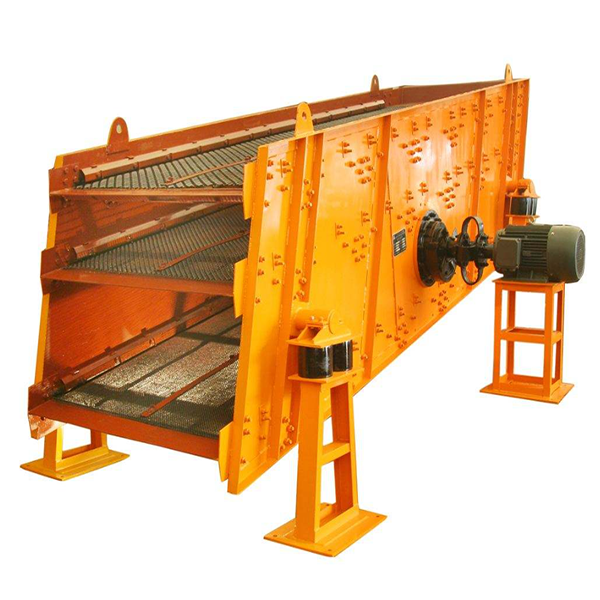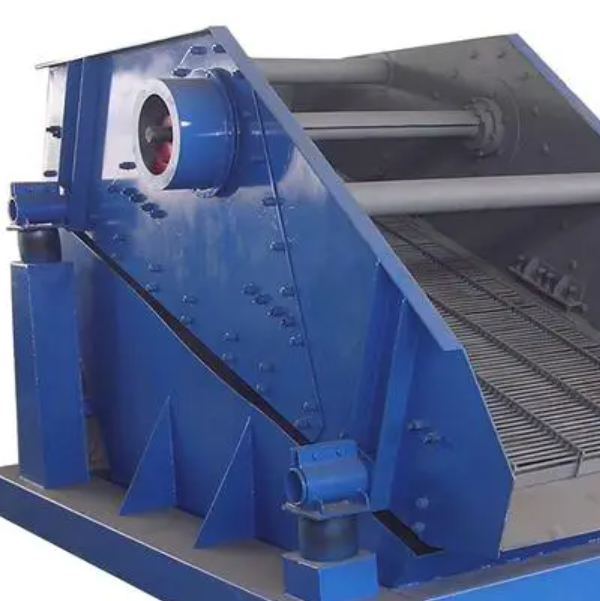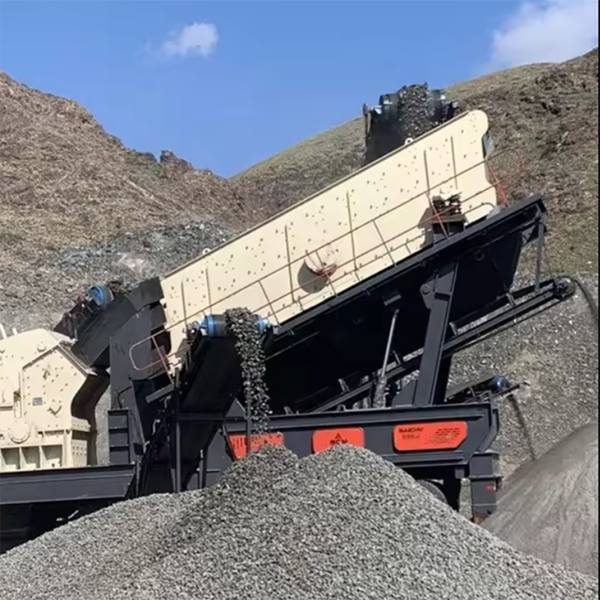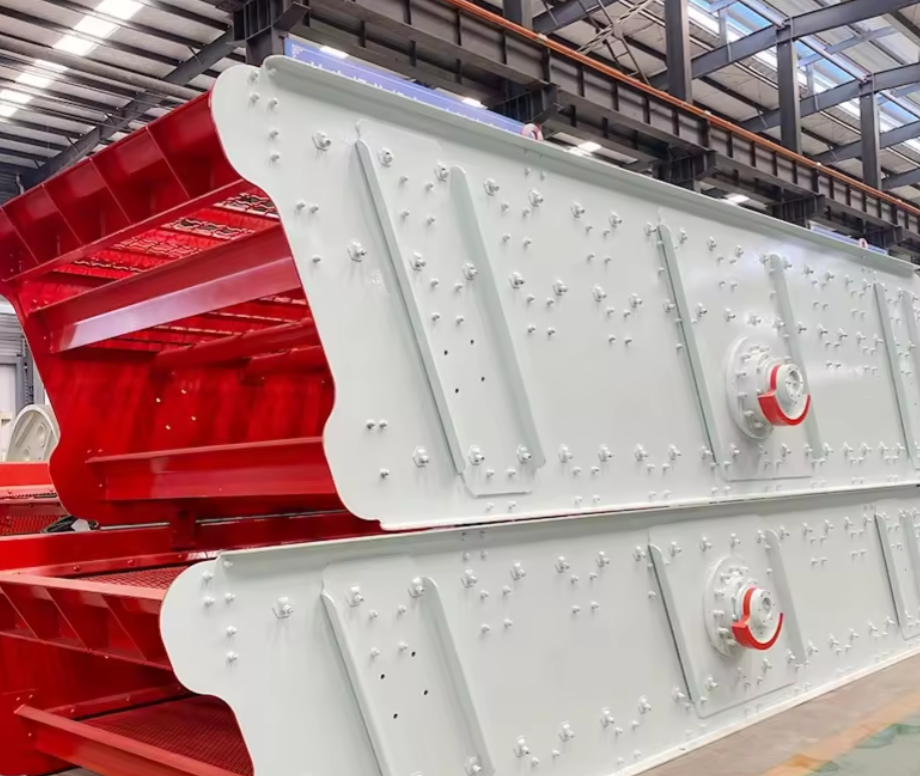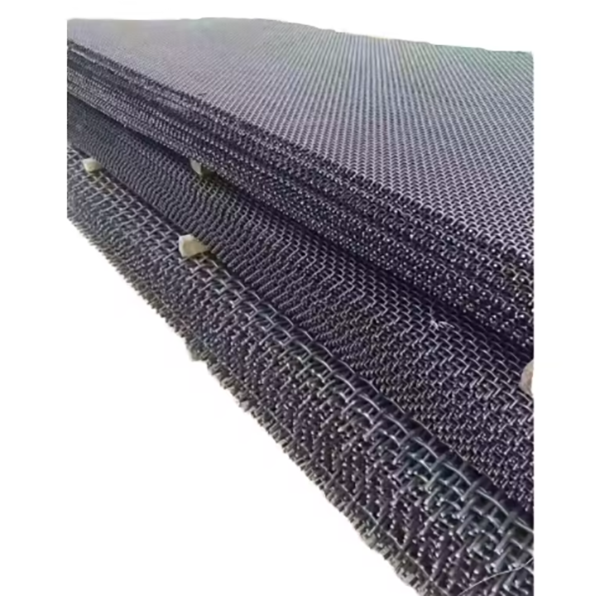The vibrating screen works by using the reciprocating vibration generated by the vibrator excitation. The upper rotating weight of the vibrator causes the screen surface to produce a plane gyration vibration, while the lower rotating weight causes the screen surface to produce a conical gyration vibration.
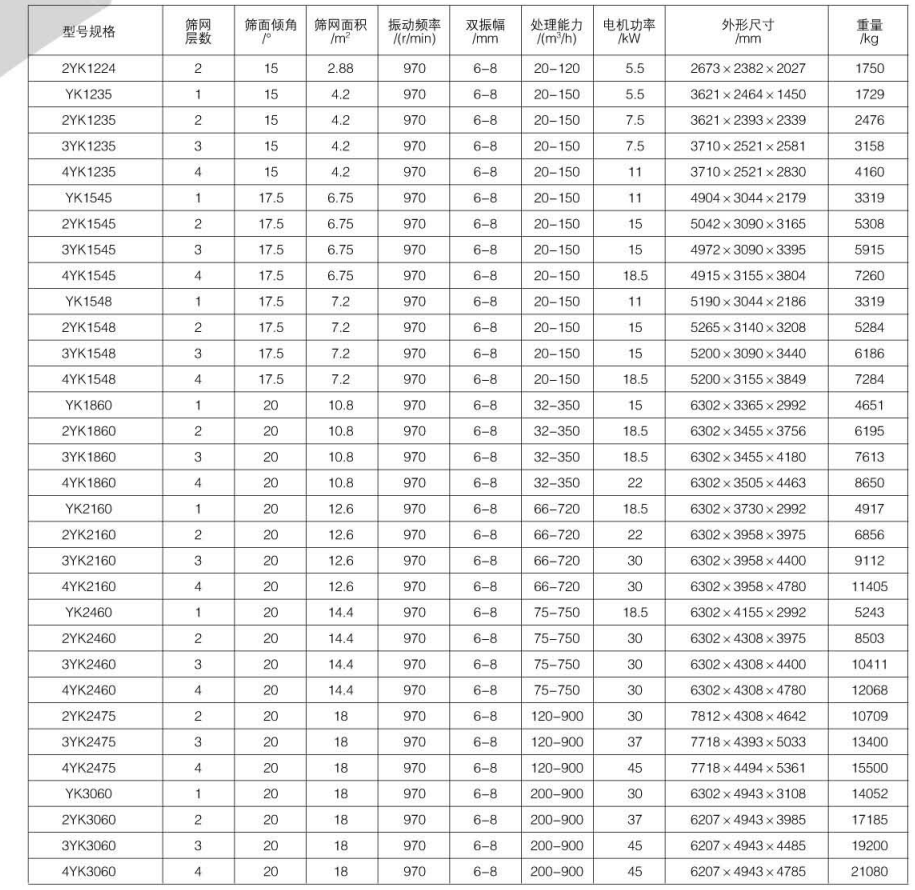
The combined effect causes the screen surface to produce a complex gyration vibration. Its vibration trajectory is a complex space curve. The curve is projected as a circle on the horizontal plane and an ellipse on the vertical plane. The amplitude can be changed by adjusting the exciting force of the upper and lower rotating weights. And adjusting the spatial phase angle of the upper and lower weights can change the curve shape of the screen surface motion trajectory and change the motion trajectory of the material on the screen surface.
Vibrating screen is a mechanical equipment that uses vibration to screen materials such as ores. It is mainly used to classify materials with different particle sizes according to particle size. The following is a detailed introduction and manufacturing process of vibrating screen:
- **Detailed introduction**:
- **Working principle**: The vibrating screen generates reciprocating rotary vibration through the excitation of the vibrator, making the materials on the screen surface move up and down and in the forward direction. At the same time, due to the different movement of materials of different particle sizes, layering occurs, thereby strengthening the screening of fine particles.
- **Basic structure**: The vibrating screen mainly consists of parts such as an exciter, a working body (screen box), and elastic elements (supporting or hanging devices). The exciter is used to generate exciting force. The working body is the working part that performs periodic movement. Elastic elements include main vibration springs and isolation springs.
- **Classification**: There are many types of vibrating screens. According to the type of movement trajectory of their screen boxes, they can be divided into vibrating screens with circular movement trajectories (circular vibrating screens) and vibrating screens with linear movement trajectories (linear vibrating screens). According to whether they are close to or far from the resonance frequency, they can be divided into resonance screens and inertial screens. According to different exciting forces, vibrating screens can be divided into eccentric vibrating screens, inertial vibrating screens and electromagnetic vibrating screens.
- **Application fields**: Vibrating screens are widely used in chemical, food, pharmaceutical, metallurgy, building materials and other industries. They are mainly used for filtering impurities and grading particle sizes.
- **Manufacturing process**:
- **Design and material selection**: According to the use requirements and working conditions of the vibrating screen, design and select materials. Select appropriate materials such as steel and rubber to ensure the strength and durability of the vibrating screen.
- **Processing and manufacturing**: According to the design drawings, perform processing and manufacturing. This includes processes such as cutting, welding, and drilling to manufacture various parts of the vibrating screen.
- **Assembly and debugging**: Assemble the manufactured parts and install the exciter, screen box, elastic elements, etc. Then perform debugging to adjust parameters such as the amplitude and frequency of the vibrating screen to ensure its normal operation.
- **Quality inspection**: Perform quality inspection on the manufactured vibrating screen, including appearance inspection, dimensional inspection, and performance testing. Ensure that the vibrating screen meets relevant standards and requirements.
- **Packaging and transportation**: Package the inspected vibrating screen to protect it from damage during transportation. Then transport it and deliver the vibrating screen to the user.
It should be noted that different types of vibrating screens may have different manufacturing processes. The specific manufacturing process should be determined according to the type and requirements of the vibrating screen.
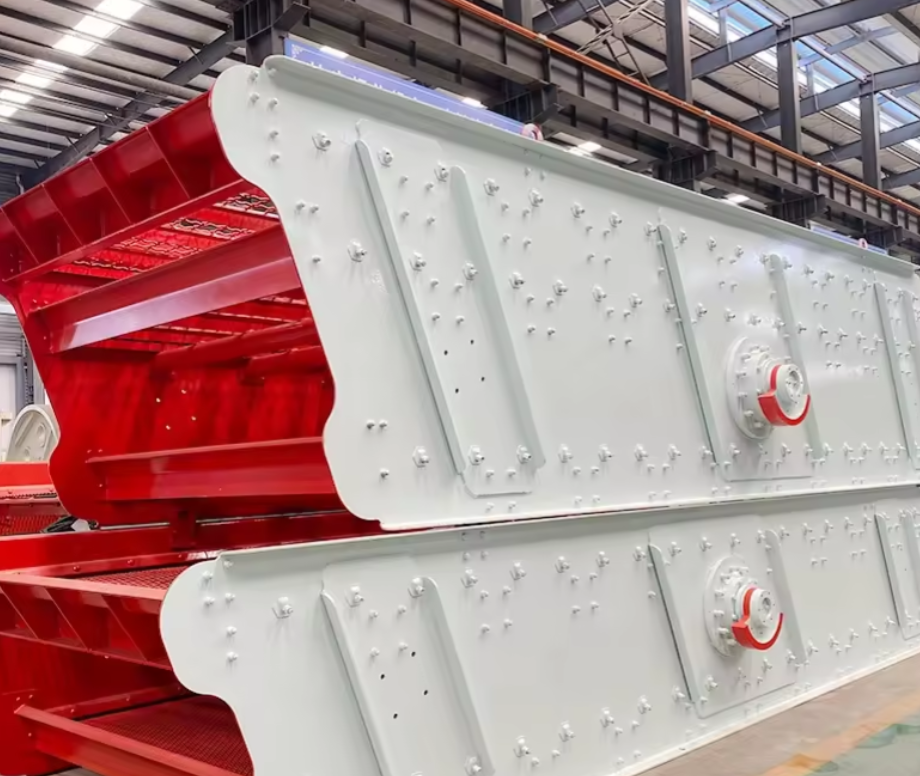
Mining vibrating screens are critical equipment used in mining, metallurgy, and construction materials industries for material classification, dewatering, and medium removal. Their manufacturing processes and quality control directly impact screening efficiency, operational stability, and service life. The following details the manufacturing process and quality control measures:
The core components of a mining vibrating screen include the screen box (side plates, cross beams, screen surface), vibration motor (or exciter), spring damping system, and supporting devices. The manufacturing process revolves around component processing and final assembly, with specific steps as follows:
The screen box, which withstands high-frequency vibrations and material impacts, directly affects equipment stability.
Vibration Motor: Purchased or customized, with core parameters (e.g., exciting force, rotational speed) matching screen box loads. Manufacturing complies with GB/T 13860 Technical Specifications for Vibration Motors. Key processes include rotor dynamic balancing (balance accuracy Grade G6.3) and stator winding insulation treatment (varnish dipping and drying, insulation resistance ≥50MΩ).
Eccentric Block Exciter:
Eccentric Blocks: Cast from cast steel (e.g., ZG35), annealed to eliminate internal stress, then machined on CNC milling machines for eccentric holes and mounting surfaces. Eccentricity error ≤0.1mm, and weight difference between paired blocks ≤5g (to ensure symmetric exciting force).
Bearing Housings: Cast from gray cast iron (HT250), stress-relieved after machining. Bearing mating surfaces have roughness ≤Ra1.6μm for precise bearing installation.
Assembly: Bearings are installed via hot fitting (heating temperature 80–100℃). High-temperature grease (e.g., lithium-based grease) is injected, with 双唇 skeleton oil seals to prevent leakage.
Pre-Assembly Positioning: Side plates are fixed on an assembly platform (flatness ≤0.5mm/m). Cross beams and exciter mounting seats are positioned using fixtures, ensuring coaxiality of component centerlines ≤0.3mm/m.
Fastening Connections: High-strength bolts (e.g., Grade 8.8) are tightened to specified torques (e.g., 350–400N·m for M20 bolts). Critical joints (e.g., exciter to screen box) use locknuts or spot welding for anti-loosening.
Vibration Motor/Exciter Installation: Mounting surfaces with the screen box have ≥90% contact. Dial indicators calibrate parallelism between exciter axes and screen box centerlines ≤0.1mm/100mm to avoid additional torque during operation.
Spring and Support Assembly: Horizontal error of spring upper/lower seats ≤1mm, and height difference among springs on the same side ≤2mm to ensure stable screen box vibration.
Screen Surface Installation: The screen surface is fixed to the box with bolts or clips, with uniform edge clamping force to prevent loosening or tearing. Gaps at screen surface overlaps ≤1mm to avoid material leakage.
Quality control spans the entire production process, with three-level checks (material inspection, process inspection, and finished product inspection) to ensure compliance with GB/T 15241 Technical Specifications for Vibrating Screens and customer requirements.
Raw Material Inspection:
Steel plates and pipes must provide material certificates (including chemical composition and mechanical properties). Samples undergo spectral analysis (verifying C, Si, Mn content) and tensile tests (checking tensile and yield strength).
Castings (e.g., bearing housings) require non-destructive testing (UT flaw detection) to exclude shrinkage or cracks. Spring steel is tested for hardness (Rockwell tester) and metallographic structure (ensuring tempered sorbite).
Purchased parts (e.g., bearings, motors) are verified with certificates and factory test reports. Samples undergo no-load trials (motor current and temperature rise must meet standards).
Static Accuracy Inspection:
Screen Box Levelness: Measured with a level, longitudinal (material flow direction) ≤0.5mm/m, transverse ≤1mm/m.
Exciter Installation Accuracy: Dial indicators check parallelism between exciter axes and screen box centerlines (error ≤0.1mm/100mm). Bearing housing temperature rise (after 1-hour no-load operation) ≤40℃ (above ambient).
Dynamic Performance Testing:
No-Load Trial: 2-hour operation to check stable vibration (amplitude deviation ≤5%), no abnormal noise (sound pressure level ≤85dB), and no loose connections.
Load Test: Materials are loaded at designed capacity (e.g., 20–50mm ore) for 8 hours. Screening efficiency (≥95% of design value), screen surface wear (no localized excessive wear), and spring amplitude deviation (≤1mm) are verified.
Safety and Appearance Inspection:
Safety Protection: Exposed rotating parts (e.g., pulleys) require guards, and guardrails (height ≥1.2m) comply with GB 23821 Safety Distances for Preventing Access to Hazard Zones.
Appearance: Paint is evenly applied (60–80μm thickness) with no sagging or missing areas. Paint adhesion (cross-cut test) ≥Grade 1. Labels (model, power, warning signs) are clear.
Each unit is accompanied by a factory inspection report, including material certificates, critical process records, and trial data for traceability.
Large vibrating screens require certification by third-party institutions (e.g., National Mining Machinery Quality Supervision and Inspection Center) and compliance with safety standards (e.g., ISO 13850 for emergency stop requirements).
Through these manufacturing and quality control measures, mining vibrating screens achieve ≥85% screening efficiency, ≥8,000 hours of trouble-free operation, and ≥6-month screen surface service life (adjusted for material abrasiveness), meeting long-term stable operation requirements in harsh mining environments





